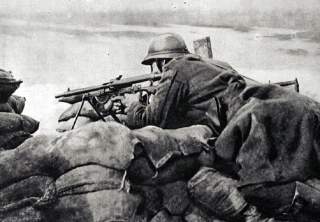Meet the Chauchat: The Worst Machine Gun Ever Made
This is why
It’s clear that if the Chauchat could have been replaced, it would have been. But it could not be replaced; there was nothing to replace it with.
One day at the auction house, someone left a pile of guns on the ground. This was not at all unusual. At the very bottom, wrapped in moving blankets, was a pile of scrap metal. I parted the blanket gently to expose more of whatever I was seeing — gently because the metal had a patina of dirty age and I didn’t want to stick myself.
(This first appeared several years ago.)
I saw an aluminum tube from a bicycle and a coiled spring. A crescent-shaped piece of metal was attached to the bicycle tube, and a brass knob was in front of a trigger guard. At the time I thought it might be some old toy, but little did I know it was one of the most feared weapons of World War I.
Once upon a time there was a gun made in France made to save The Republic in its darkest hours. Lightweight and with plenty of firepower, it promised a revolution in guns for the fighting man. It was so easy to build a bicycle company could make it — and did.
It was called the Chauchat, and it was the worst machine gun ever made.
Recommended: The 5 Biggest Nuclear Bomb Tests (From All 6 Nuclear Powers).
Recommended: How Israel Takes U.S. Weapons and Makes Them Better.
Recommended: North Korea’s Most Lethal Weapon Isn’t Nukes.
The Chauchat (pronounced “sho-sho” by American troops) was officially known as Le Fusil Mitrailleur 1915 CSRG. It was a fully-automatic weapon. It weighed 20 pounds loaded, fired standard French army rifle bullets, and came equipped with a 20-round magazine. It represented a huge leap in firepower over the standard French infantry rifle of the time, a bolt-action rifle designed in 1886 that held only eight rounds.
The Chauchat was developed in response to the battlefield conditions of the First World War.
The allied armies, particularly the French, realized that there was a need for a squad-level machine gun to fill the gap between the standard infantry rifle and the heavier, tripod-mounted machine gun.
The alternative was a light machine gun that would be particularly useful while attacking, allowing infantry to bring heavier firepower with them on the move, to clear out enemy positions and to beat off enemy counterattacks until the heavy machine guns were brought up.
At the start of World War I, France had not a single light machine gun in its inventory, and a crash program was created to acquire one. The result was the Chauchat. The Chauchat looked like bicycle parts because it was produced by the Gladiator Company, which made French bicycles, motorcycles and cars in peacetime.
The Gladiator company produced more than 200,000 rifles in the eight-millimeter Lebel cartridge, plus another 20,000 in 30.06 caliber for the U.S. Army and Marines fighting in Europe.
The Chauchat had several promising useful features. For one, it packed a lot of firepower into a relatively light package. The gun was easy to produce: so easy a bicycle company could do it. It had an integral bipod to prop the barrel up. The gun’s magazine (the crescent I had seen earlier) was open on the side, allowing the user to see how many bullets he had left.
Perhaps the greatest innovation of the Chauchat and similar weapons of that era was the ability to manufacture lightweight, high-firepower weapons from civilian industry. Converting civilian industry to wartime production meant more of a nation’s industry could be involved in the war effort.
Le désastre
The Chauchat turned out to be terribly unreliable.
Under ideal conditions, a clean, well-maintained Chauchat would jam after firing 300 rounds. Under field conditions, in the dirt and the mud of the trenches of the Western Front, it would jam after 100 rounds. Here’s the problem: anyone who had to fire 100 rounds in combat, most likely, was in trouble and needed to keep firing.
He was often in for a disappointment.
The French army model was problematic, but the American version, sloppily converted to fire the 30.06 rifle round, was even worse. In quality control tests conducted by the American Expeditionary Forces, the Chauchat had a dreadful 40-percent rejection rate.
Design flaws in the Chauchat were legion. The gun would punch the shooter in eye or cheek (what French troops called la gifle or “the slap”) if it were held improperly. The awkward, flimsy bipod legs were so long they needlessly exposed the shooter to enemy fire.
The open magazine — while fine in clean, controlled test conditions — allowed mud and dirt to get into the action and jam the rifle. The gun was an ergonomic mess, difficult to handle comfortably in combat. The metal aiming sights were poorly designed and tended to shoot low and to the right.
It’s a testament to the desperation of the times that, despite the horrible nature of the Chauchat, it was not upgraded substantially during wartime.
Despite its many flaws, substantial improvements weren’t incorporated into new models until after the war. American conversion to the 30.06 round could have been fixed by modifying the chamber dimensions. It wasn’t. The front line demanded as many Chauchats as the Gladiator company could produce, and design changes would have to wait.
The Chauchat soldiered on. Three American soldiers won the Medal of Honor with the Chauchat. Not surprisingly one recipient, Pvt. Thomas Neibaur, had his Chauchat jam after only 50 rounds while facing a horde of 50 attacking Germans, and was knocked unconscious for his trouble while fleeing his broken weapon.
It’s clear that if the Chauchat could have been replaced, it would have been. But it could not be replaced; there was nothing to replace it with.
The Allies were in a bind, and it was better than nothing. They had failed to anticipate the battlefield and develop the proper weapons, and it cost them dearly. They had neglected to realize that the revolution in firepower the machine gun delivered could be, and would be, delegated down to the individual infantryman.
It’s worth remembering. There’s also no guarantee, with ever-continuing improvements in weaponry and war machinery, that it won’t happen again.
This first appeared in WarIsBoring here.


